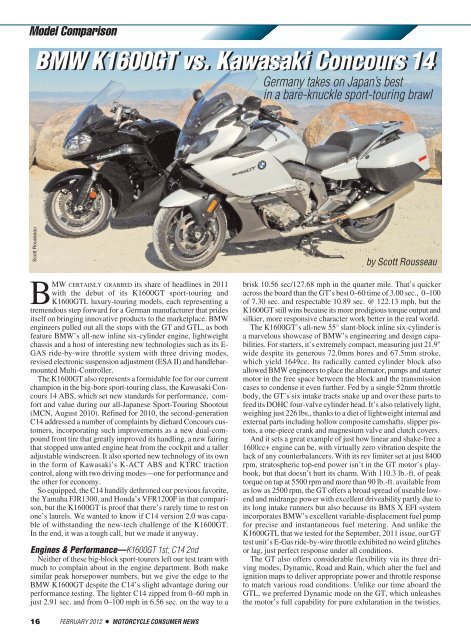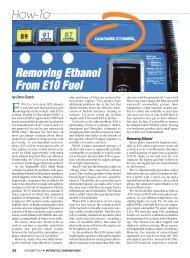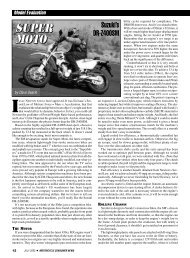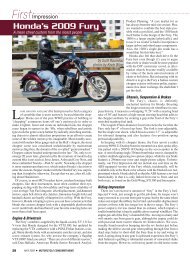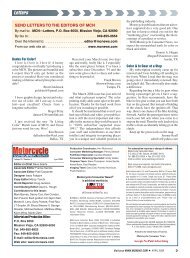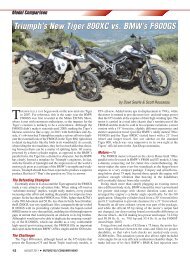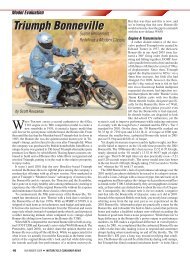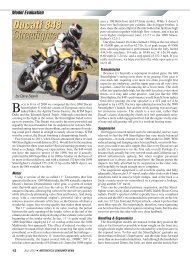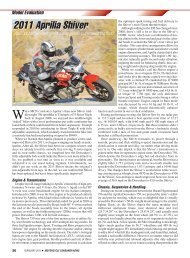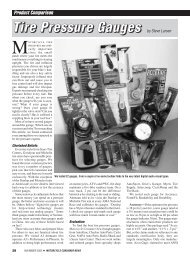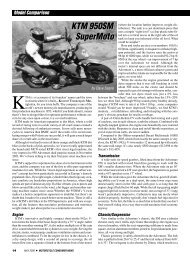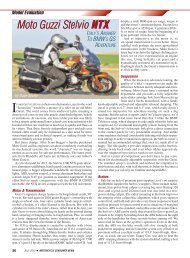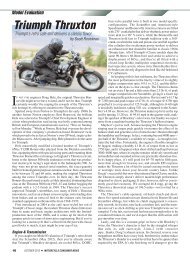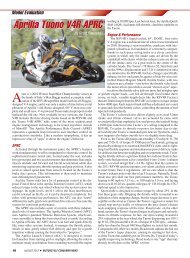BMW K1600GT vs. Kawasaki Concours 14 - Motorcycle Consumer ...
BMW K1600GT vs. Kawasaki Concours 14 - Motorcycle Consumer ...
BMW K1600GT vs. Kawasaki Concours 14 - Motorcycle Consumer ...
You also want an ePaper? Increase the reach of your titles
YUMPU automatically turns print PDFs into web optimized ePapers that Google loves.
Model Comparison<br />
<strong>BMW</strong> <strong>K1600GT</strong> <strong>vs</strong>. <strong>Kawasaki</strong> <strong>Concours</strong> <strong>14</strong><br />
Scott Rousseau<br />
<strong>BMW</strong> CERTAINLY GRABBED its share of headlines in 2011<br />
with the debut of its <strong>K1600GT</strong> sport-touring and<br />
<strong>K1600GT</strong>L luxury-touring models, each representing a<br />
tremendous step forward for a German manufacturer that prides<br />
itself on bringing innovative products to the marketplace. <strong>BMW</strong><br />
engineers pulled out all the stops with the GT and GTL, as both<br />
feature <strong>BMW</strong>’s all-new inline six-cylinder engine, lightweight<br />
chassis and a host of interesting new technologies such as its E-<br />
GAS ride-by-wire throttle system with three driving modes,<br />
revised electronic suspension adjustment (ESA II) and handlebarmounted<br />
Multi-Controller.<br />
The <strong>K1600GT</strong> also represents a formidable foe for our current<br />
champion in the big-bore sport-touring class, the <strong>Kawasaki</strong> <strong>Concours</strong><br />
<strong>14</strong> ABS, which set new standards for performance, comfort<br />
and value during our all-Japanese Sport-Touring Shootout<br />
(MCN, August 2010). Refined for 2010, the second-generation<br />
C<strong>14</strong> addressed a number of complaints by diehard <strong>Concours</strong> customers,<br />
incorporating such improvements as a new dual-compound<br />
front tire that greatly improved its handling, a new fairing<br />
that stopped unwanted engine heat from the cockpit and a taller<br />
adjustable windscreen. It also sported new technology of its own<br />
in the form of <strong>Kawasaki</strong>’s K-ACT ABS and KTRC traction<br />
control, along with two driving modes—one for performance and<br />
the other for economy.<br />
So equipped, the C<strong>14</strong> handily dethroned our previous favorite,<br />
the Yamaha FJR1300, and Honda’s VFR1200F in that comparison,<br />
but the <strong>K1600GT</strong> is proof that there’s rarely time to rest on<br />
one’s laurels. We wanted to know if C<strong>14</strong> version 2.0 was capable<br />
of withstanding the new-tech challenge of the <strong>K1600GT</strong>.<br />
In the end, it was a tough call, but we made it anyway.<br />
Engines & Performance—<strong>K1600GT</strong> 1st; C<strong>14</strong> 2nd<br />
Neither of these big-block sport-tourers left our test team with<br />
much to complain about in the engine department. Both make<br />
similar peak horsepower numbers, but we give the edge to the<br />
<strong>BMW</strong> <strong>K1600GT</strong> despite the C<strong>14</strong>’s slight advantage during our<br />
performance testing. The lighter C<strong>14</strong> zipped from 0–60 mph in<br />
just 2.91 sec. and from 0–100 mph in 6.56 sec. on the way to a<br />
16 FEBRUARY 2012 ● MOTORCYCLE CONSUMER NEWS<br />
Germany takes on Japan’s best<br />
in a bare-knuckle sport-touring brawl<br />
by Scott Rousseau<br />
brisk 10.56 sec/127.68 mph in the quarter mile. That’s quicker<br />
across the board than the GT’s best 0–60 time of 3.00 sec., 0–100<br />
of 7.30 sec. and respectable 10.89 sec. @ 122.13 mph, but the<br />
<strong>K1600GT</strong> still wins because its more prodigious torque output and<br />
silkier, more responsive character work better in the real world.<br />
The <strong>K1600GT</strong>’s all-new 55° slant-block inline six-cylinder is<br />
a marvelous showcase of <strong>BMW</strong>’s engineering and design capabilities.<br />
For starters, it’s extremely compact, measuring just 21.9"<br />
wide despite its generous 72.0mm bores and 67.5mm stroke,<br />
which yield 1649cc. Its radically canted cylinder block also<br />
allowed <strong>BMW</strong> engineers to place the alternator, pumps and starter<br />
motor in the free space between the block and the transmission<br />
cases to condense it even further. Fed by a single 52mm throttle<br />
body, the GT’s six intake tracts snake up and over these parts to<br />
feed its DOHC four-valve cylinder head. It’s also relatively light,<br />
weighing just 226 lbs., thanks to a diet of lightweight internal and<br />
external parts including hollow composite camshafts, slipper pistons,<br />
a one-piece crank and magnesium valve and clutch covers.<br />
And it sets a great example of just how linear and shake-free a<br />
1600cc+ engine can be, with virtually zero vibration despite the<br />
lack of any counterbalancers. With its rev limiter set at just 8400<br />
rpm, stratospheric top-end power isn’t in the GT motor’s playbook,<br />
but that doesn’t hurt its charm. With 110.3 lb.-ft. of peak<br />
torque on tap at 5500 rpm and more than 90 lb.-ft. available from<br />
as low as 2500 rpm, the GT offers a broad spread of useable lowend<br />
and midrange power with excellent driveability partly due to<br />
its long intake runners but also because its BMS X EFI system<br />
incorporates <strong>BMW</strong>’s excellent variable-displacement fuel pump<br />
for precise and instantaneous fuel metering. And unlike the<br />
<strong>K1600GT</strong>L that we tested for the September, 2011 issue, our GT<br />
test unit’s E-Gas ride-by-wire throttle exhibited no weird glitches<br />
or lag, just perfect response under all conditions.<br />
The GT also offers considerable flexibility via its three driving<br />
modes, Dynamic, Road and Rain, which alter the fuel and<br />
ignition maps to deliver appropriate power and throttle response<br />
to match various road conditions. Unlike our time aboard the<br />
GTL, we preferred Dynamic mode on the GT, which unleashes<br />
the motor’s full capability for pure exhilaration in the twisties.
Scott Rousseau<br />
“Road” creates slightly less snappy throttle response, although it’s<br />
nowhere near as muted as Rain, which substantially reduces<br />
torque and horsepower. While Rain certainly has its place on<br />
swampy roads, it sucks the life out of the K motor when activated<br />
in the dry.<br />
The GT can also be ordered with <strong>BMW</strong>’s S1000RR-derived,<br />
gyroscope-based Dynamic Traction Control, which features<br />
separate levels of traction control for each driving mode,<br />
although our experience with the DTC is that it cuts power<br />
too abruptly.<br />
Introduced in 2007 and based on <strong>Kawasaki</strong>’s powerhouse Ninja<br />
ZX-<strong>14</strong>, the <strong>Concours</strong> <strong>14</strong>’s DOHC inline four is a formidable<br />
opponent for the all-new <strong>BMW</strong>, delivering robust power while its<br />
gear-driven counterbalancers quell unwanted vibration. The C<strong>14</strong><br />
also features different driving modes—but just two: Full Power<br />
and ECO Mode, the latter curtailing throttle response—but not too<br />
much power—for better fuel economy. Compared to the GT, the<br />
C<strong>14</strong>’s KTRC traction control smoothly reduces power to prevent<br />
wheelspin when traction is compromised.<br />
On the dyno, our 2011 C<strong>14</strong> delivered practically identical numbers<br />
to the 2010 model in Full Power mode, topping out at 135.6<br />
rwhp @ 8750 rpm. On the street, throttle response through its<br />
bank of 40mm throttle bodies is positively velvety, but it just<br />
doesn’t feel as strong down low as the GT motor because the<br />
C<strong>14</strong>’s 91.4 lb.-ft. peak torque output isn’t as hearty and occurs at<br />
a much higher 7250 rpm. Furthermore, the C<strong>14</strong> uses a<br />
Variable Valve Timing mechanism that relies on oil<br />
pressure to advance its cams for optimum power, and<br />
the slight lag time required to build this oil pressure<br />
undoubtedly contributes to its less authoritative feel<br />
below 6000 rpm. It’s especially noticeable during topgear<br />
roll-ons at 65 mph, when, while turning over at<br />
just 3200 rpm in its overdrive sixth gear, the C<strong>14</strong> will<br />
often require a downshift to pass traffic.<br />
Transmissions, Clutches & Drivelines—C<strong>14</strong><br />
1st; <strong>K1600GT</strong> 2nd<br />
Both machines utilize six-speed transmissions and<br />
wet multi-plate slipper clutches, but the C<strong>14</strong>’s gearbox<br />
is vastly superior to the <strong>K1600GT</strong>’s stacked-shaft<br />
transmission, offering positive gear changes and<br />
smoother shifting regardless of rpm, load or throttle<br />
position. The Kawi’s clutch is also equipped with a<br />
radial pump master cylinder that contributes to its more<br />
linear lever feel.<br />
Scott Rousseau<br />
The <strong>K1600GT</strong>’s hydraulic-assist clutch offers a light<br />
pull, but it also generates a peculiar, snatchy feel at the<br />
lever that changes depending on rpm and/or load. This<br />
is because <strong>BMW</strong> engineers fitted the clutch with a variable<br />
pressure plate system in an attempt to decrease<br />
lever effort, which it does, but which also tends to<br />
decrease the range of the friction zone as rpm increases.<br />
Even less endearing, feedback from the GT’s driveline<br />
can be felt through the clutch lever, which pulses in and<br />
out during acceleration and deceleration. The GT’s<br />
transmission action is surprisingly notchy, too, and it’s<br />
perhaps the least refined attribute of the new <strong>BMW</strong>.<br />
Both of these shaft-drive sport-tourers incorporate<br />
systems intended to isolate their rear suspensions from<br />
driveshaft-induced lift and squat, but the C<strong>14</strong>’s Tetra-<br />
Lever does a better job than the GT’s Paralever. The<br />
C<strong>14</strong>’s dual-sided four-link arrangement emulates the<br />
behavior of a chain-driven motorcycle by constantly<br />
keeping the motor output drive on the same plane as the<br />
final drive, and the system works like a charm, giving the<br />
C<strong>14</strong> the smoothest and least cumbersome shaft-drive ride quality<br />
we’ve yet experienced. The GT’s single-sided, parallelogram-style<br />
Paralever allows more driveline-influenced lift and squat during<br />
heavy acceleration and deceleration than the C<strong>14</strong>.<br />
Suspension—<strong>K1600GT</strong> 1st; C<strong>14</strong> 2nd<br />
The C<strong>14</strong>’s excellent shaft-drive system might lead one to logically<br />
conclude that it has the best suspension feel as well, but the<br />
<strong>K1600GT</strong> really turns the tables on the <strong>Kawasaki</strong> when it comes<br />
to overall ride quality in this category. Offering 4.5" of front<br />
wheel travel and 5.3" in the rear, <strong>BMW</strong>’s Norman Hossackinspired,<br />
Duolever double-A arm front suspension and Paralever<br />
rear dazzle with the high-tech convenience of <strong>BMW</strong>’s updated<br />
change-on-the-fly ESA II electronic suspension adjustment,<br />
which offers multiple preset levels of front and rear damping as<br />
well as rear preload and spring rate adjustability. The ESA II features<br />
presets for solo riders, solo-with-luggage or two-up with<br />
luggage, giving nine variations in all. Unlike our experience with<br />
the <strong>K1600GT</strong>L pitted against the Honda Gold Wing (September,<br />
2012), the <strong>K1600GT</strong>s settings provided noticeable variations<br />
of enjoyable suspension quality for a variety of road<br />
conditions. Find yourself on a smooth, twisty backroad? The<br />
GT’s Sport Mode offers firm yet compliant compression and<br />
rebound damping that makes canyon carving a delight. Hammering<br />
out some serious freeway mileage? Switching to the GT’s<br />
Visit us at WWW.MCNEWS.COM ● FEBRUARY 2012 17
Model Comparison<br />
Scott Rousseau<br />
Comfort Mode softens up the damping for a true easy chair feel.<br />
Naturally, Normal is a compromise between the two, and it was<br />
the mode we found ourselves in the least on the GT. Ironically,<br />
it was our preferred mode on the heavier GTL.<br />
Adjustable for preload and rebound damping but not compression<br />
damping, the C<strong>14</strong>’s 43mm male-slider fork offers 4.4" of<br />
front wheel travel and its single shock offers 5.4" of rear wheel<br />
travel. To its credit, the C<strong>14</strong>’s suspension achieves an acceptable<br />
balance between a taut sportbike feel and plush tourer on the<br />
highway, but the GT’s change-on-the-fly damping spoils its rider,<br />
while the C<strong>14</strong> rider must stop and break out the wrenches and<br />
screwdrivers to dial in what is, at best, a compromised ride. Our<br />
attempts at matching the C<strong>14</strong>’s ride to the GT’s left us wishing for<br />
compression adjusters to fine-tune the fork, something any OEM<br />
flagship sport-tourer with manually adjustable suspension should<br />
include in the package. Also, while the C<strong>14</strong> offers tremendous<br />
compliance and control, its front fork performance is hampered<br />
when the rear brake is applied—but more on this later.<br />
Brakes—<strong>K1600GT</strong> 1st; C<strong>14</strong> 2nd<br />
When it comes to braking performance and feel, the <strong>BMW</strong><br />
<strong>K1600GT</strong> easily upstages the <strong>Kawasaki</strong> <strong>Concours</strong> <strong>14</strong>. Both offer<br />
ABS and their own version of linked braking, with the C<strong>14</strong>’s<br />
<strong>Kawasaki</strong> Advanced Coactive-braking Technology (K-ACT)<br />
linking its dual 310mm front rotors and radially mounted fourpiston<br />
calipers with its single 270mm rear rotor/dual-piston<br />
caliper front-to-back and back-to-front. The C<strong>14</strong> features two<br />
combined modes, Solo and High Combined, which adjust the<br />
brake bias for one- or two-up riding. The GT’s 320mm rotors use<br />
four-piston double-action calipers up front and a dual-piston,<br />
double-action caliper in the rear with a partially integrated ABS<br />
in which the rear brake is completely independent of the fronts,<br />
while applying the front brake lever does activate a portion of the<br />
rear brake’s power.<br />
The <strong>BMW</strong>’s front brakes offer excellent stopping power and an<br />
extremely linear feel that inspires rider confidence, and so do the<br />
C<strong>14</strong>’s, but the difference between the two machines lies mostly<br />
in the rear. The C<strong>14</strong>’s rear brake feels more snatchy than the<br />
GT’s, a sensation created more by the fact that the K-ACT exerts<br />
too much influence on the front brake than because of any flaw<br />
in the rear brake by itself. Applying the rear brake causes the<br />
C<strong>14</strong>’s front end to settle too much for our tastes and makes<br />
trailbraking into a corner more of a challenge. The GT’s Duolever<br />
front suspension resists such dive under braking.<br />
18 FEBRUARY 2012 ● MOTORCYCLE CONSUMER NEWS<br />
Out on our test range, the <strong>BMW</strong>’s brakes proved their<br />
superiority by posting shorter stops from 60 mph than the<br />
lighter C<strong>14</strong> did. The GT’s best result was a very good<br />
123.8'—almost 1.0 G of stopping power in a machine<br />
with full-time ABS—while the C<strong>14</strong>’s best performance<br />
was a respectable but marginally longer 127.8'.<br />
Chassis & Handling—<strong>K1600GT</strong> 1st; C<strong>14</strong> 2nd<br />
Based on their weight alone, one might expect the<br />
<strong>BMW</strong> <strong>K1600GT</strong> to be the heavier handling sport-tourer<br />
of this pair, but while the 745.5-lb. GT outweighs the<br />
695.5-lb. <strong>Kawasaki</strong> <strong>Concours</strong> <strong>14</strong> by 50 lbs., the GT wins<br />
our Handling category. The GT’s 66.1" wheelbase is<br />
rangier than the C<strong>14</strong>’s 59.8", and its 27.8° rake is more<br />
relaxed than the C<strong>14</strong>’s (26.1°), but the GT is lighter-steering<br />
than the C<strong>14</strong> at all speeds and easily outpaces it in the<br />
canyons, even though the Duolever tends to isolate the<br />
rider from the road more than we’d like. The GT’s all-new<br />
chassis, a combination of “chill cast” aluminum, magnesium<br />
and a welded square-tube alloy subframe, weighs<br />
just 35 lbs., yet it’s rigid enough not to feel flimsy when<br />
the GT is ridden aggressively. Its side-to-side agility is also<br />
admirable. The overall package imparts an intuitive feel that only<br />
increases the rider’s confidence with each passing mile.<br />
The C<strong>14</strong>’s chassis is based on the Ninja ZX-<strong>14</strong>’s, but significant<br />
changes include a redesigned swingarm attachment point to<br />
accommodate the shaft drive, and different upper and lower cross<br />
members. Increasing its rake 2.5° achieved more stability but<br />
also required a revised frame casting with increased wall thickness,<br />
which happily results in more torsional rigidity and crisper<br />
handling than the old ZX-<strong>14</strong>.<br />
The Kawi exhibits a neutral handling character, but its steering,<br />
while no less precise than the <strong>BMW</strong>’s, is more deliberate. It’s as<br />
if the C<strong>14</strong> is carrying its weight higher in the chassis than it really<br />
is, even though its slightly lower CofG tells a different tale. Still,<br />
the C<strong>14</strong> is a model of stability, and hardcore riders may find it to<br />
be the more capable of the two at a fast pace in high-speed sweepers,<br />
but the GT is still the more nimble machine despite carrying<br />
slightly more weight on its front wheel (49.6% <strong>vs</strong>. 47.2% for the<br />
C<strong>14</strong>). The <strong>Kawasaki</strong> handles extremely well. The <strong>BMW</strong> handles<br />
like a dream.<br />
Ergonomics—<strong>K1600GT</strong> 1st; C<strong>14</strong> 2nd<br />
While both of these sport-tourers feature electrically adjustable<br />
windscreens, the <strong>BMW</strong> <strong>K1600GT</strong>’s greater frontal area and wider<br />
screen provide more protection from the elements than the<br />
<strong>Kawasaki</strong> <strong>Concours</strong> <strong>14</strong>, increasing rider comfort over the long<br />
haul. But behind the screen, the <strong>BMW</strong>’s higher and wider handlebars<br />
are less of a reach, and its flat, comfy seat is a real ergonomic<br />
advantage over the C<strong>14</strong>, whose lower and more forward-mounted<br />
bars and high-back saddle tend to force the rider forward in the<br />
ergonomic triangle, hindering the ability to move around on the<br />
seat during long rides. The difference in feel is considerable<br />
despite their very similar seat heights, 31.75" for the GT and<br />
31.6" for the C<strong>14</strong>.<br />
Instruments/Controls—<strong>K1600GT</strong> 1st; C<strong>14</strong> 2nd<br />
The <strong>K1600GT</strong> and the <strong>Concours</strong> <strong>14</strong> offer all of the amenities<br />
a long-distance rider will need, including temperature-adjustable<br />
heated grips and instrumentation with multi-function trip computers.<br />
The C<strong>14</strong>’s easy-to-read LCD display can be scrolled through<br />
via a button on the front of the left handlebar.<br />
But for all-out command and control, the GT’s left handlebarmounted<br />
Multi Controller is hard to beat, offering access to<br />
practically all of the GT’s adjustable features, including the
ESA, driving modes and grip heat, via the rotation of a single<br />
knob. It takes a little getting used to, but it is very intuitive and<br />
fun to use.<br />
Riding Impression—<strong>K1600GT</strong> 1st; C<strong>14</strong> 2nd<br />
With their powerhouse engines, neutral handling, excellent<br />
wind protection and heated grips, the <strong>K1600GT</strong> and the <strong>Concours</strong><br />
<strong>14</strong> are excellent platforms from which to view the world in<br />
fast motion. The <strong>Concours</strong> <strong>14</strong> offers up the more aggressive feel<br />
with its slightly forward seating position and lower handlebars.<br />
But there are two things that make the GT stand out during<br />
long rides. The first is its Multi-Controller, which gives the rider<br />
plenty of options to fiddle with and occupy time while droning<br />
down a desolate stretch of highway. Even better, though, is the<br />
amazingly raspy exhaust note that emanates from the GT’s dual<br />
mufflers. With less baffling than the GTL, the GT’s mufflers<br />
allow the rider to enjoy the <strong>BMW</strong> six’s exciting exhaust note,<br />
which is more reminiscent of a 12-cylinder Ferrari or Lamborghini<br />
than any German vehicle we’ve ever heard. It makes running<br />
the GT through its gears all the more enjoyable.<br />
The fuel economy delivered by these two is reflective of their<br />
big-block powerplants, and admittedly we aren’t overly confident<br />
that our GT’s fuel mileage is entirely accurate. The problem<br />
lies with the fact that the GT’s fuel filler neck incorporates<br />
a long plastic spigot that extends down into the tank and makes<br />
it difficult to tell when the GT’s 7.0-gal. fuel tank is topped. At<br />
any rate, our GT averaged 42.4 mpg, while the C<strong>14</strong> averaged<br />
37.4 mpg. For more perspective, you can compare these<br />
numbers to the 37.9 mpg that we recorded for the GTL in our<br />
September, 2011, touring comparison and to the 43.3 mpg that<br />
the C<strong>14</strong> averaged on our long-distance Japanese Sport Touring<br />
Shootout in August, 2010.<br />
Attention to Detail—<strong>K1600GT</strong> 1st; C<strong>14</strong> 2nd<br />
If not for two irritating so-called “amenities,” the <strong>Kawasaki</strong> might<br />
have equaled the <strong>BMW</strong> in this category. First is <strong>Kawasaki</strong>’s Intelligent<br />
Proximity Activation Start System (KIPASS), which does away<br />
with the traditional motorcycle key in favor of a remote key fob that<br />
secures the C<strong>14</strong> whenever the fob is more than 5.25' from the motorcycle.<br />
We’re all for security, however, this system has severe drawbacks.<br />
First is that you cannot open the fuel cap or remove the<br />
saddlebags without the fob, as it locks the C<strong>14</strong>’s over-sized ignition<br />
key into the ignition. You can use the accessory key located in the<br />
fob if you should happen to have it with you, but the entire<br />
arrangement is more of a hassle than it’s worth.<br />
The second is the C<strong>14</strong>’s map case. <strong>Kawasaki</strong> engineers<br />
relocated it from the fuel tank to the left side of the<br />
fairing for 2010, but the new case door’s latch mechanism<br />
is far from precise, often requiring serious prying<br />
to get it to release. By the same token, the door can also<br />
require several attempts just to close it securely.<br />
On the plus side, the C<strong>14</strong>’s saddlebags are easy to<br />
open and easy to remove—if you have the key fob—<br />
and its grip heaters offer plenty of warmth for cold riding<br />
days. Also redesigned in 2010, <strong>Kawasaki</strong>’s lower<br />
fairing does a fantastic job of keeping heat off the rider<br />
on warmer days.<br />
The <strong>K1600GT</strong> exudes a high degree of fit and finish<br />
without any noticeable glitches, but it isn’t perfect. Its<br />
annoying fuel tank filler neck is a perfect example.<br />
Another is that while its swing-out air scoops do an<br />
excellent job of ventilating the cockpit in warm weather,<br />
there are no detents to allow the rider to incrementally<br />
adjust their airflow. Adding detents would be a small<br />
improvement that could greatly increase rider comfort.<br />
Scott Rousseau<br />
Value—C<strong>14</strong> 1st; <strong>K1600GT</strong> 2nd;<br />
If you’ve read any of our recent model comparisons that have<br />
included <strong>BMW</strong> motorcycles, then you probably know the challenge<br />
in justifying price <strong>vs</strong>. value of motorcycles in the same<br />
class as a <strong>BMW</strong>. The GT’s base MSRP of $20,900 is nearly $5000<br />
more than the <strong>Kawasaki</strong>, but that doesn’t even scratch the surface<br />
of the GT’s available trim packages.<br />
The base <strong>K1600GT</strong> does include a fixed Xenon headlight with<br />
<strong>BMW</strong>’s dynamic leveling feature, heated seat and heated grips,<br />
cruise control, the multi-function display, on-board computer<br />
and Multi-Controller, the integral ABS package, the E-Gas throttle<br />
with power modes, the electrically adjustable windscreen and<br />
a luggage rack. <strong>BMW</strong>’s Standard Package increases the price to<br />
$23,405 and adds the ESA II electronic suspension adjustment,<br />
GPS-ready wiring and a safety package that includes the Xenon<br />
adaptive headlight, dynamic traction control and tire pressure<br />
monitoring system. Stepping up to the Premium Package for<br />
$24,540 includes all of the above plus a full audio system with a<br />
radio, Sirius satellite radio (with a free one-year subscription),<br />
iPod/USB integration, and an auxiliary input and additional security<br />
features in the form of a power locking system and an alarm.<br />
The 2011 <strong>Kawasaki</strong> <strong>Concours</strong> <strong>14</strong> ABS, as tested here, costs<br />
$15,599. While it lacks all the rider-pampering features of the<br />
GT, it does include two power modes, ABS, traction control, an<br />
electrically adjustable windshield and heated grips.<br />
Simply put, if price is important to you, then the <strong>Kawasaki</strong><br />
<strong>Concours</strong> <strong>14</strong> wins this category, hands down. If the status appeal<br />
of the <strong>BMW</strong> plays a big role in your purchasing decision, the<br />
GT may well justify its hefty premium.<br />
Overall—<strong>K1600GT</strong> 1st; C<strong>14</strong> 2nd<br />
The <strong>Kawasaki</strong> <strong>Concours</strong> <strong>14</strong> ABS is an extremely polished<br />
sport-tourer, with a powerful yet civilized engine, supple suspension<br />
and very good handling character. What it lacks in hightech<br />
gadgetry it makes up for with a purist’s sport-touring ride.<br />
It’s still the best Japanese sport-tourer we’ve ever ridden. The<br />
<strong>BMW</strong> <strong>K1600GT</strong> sets a new bar for the category with its sweetrunning<br />
six-cylinder engine, luxurious comfort and its impressive<br />
array of new technology. For most potential buyers, choosing a<br />
winner will come down to cost. The <strong>Kawasaki</strong> represents the best<br />
value in the over-1000cc sport-touring class today, but the <strong>BMW</strong><br />
is simply at the head of the class. If you want the best, you can get<br />
it in the <strong>BMW</strong>, but it will cost you.<br />
Visit us at WWW.MCNEWS.COM ● FEBRUARY 2012 19
Model Comparison<br />
Right: The GT’s flat, narrow and cushy<br />
saddle provides all-day comfort for<br />
rider and passenger. The rider’s seat<br />
height is 31.75".<br />
Below: The GT’s cockpit is roomy, and<br />
its handlebars provide plenty of leverage.<br />
Most of the GT’s riding functions<br />
are accessible via <strong>BMW</strong>’s unique Multi-<br />
Controller wheel located just inboard of<br />
the left handgrip. <strong>BMW</strong> purists probably<br />
won’t like the GT’s UJM-style turn signal<br />
switchgear, but we do.<br />
TESTERS’ LOG<br />
In my opinion, this <strong>K1600GT</strong>, as opposed to the GTL, is the bike<br />
that <strong>BMW</strong>’s engineers set out to build. The GTL was just a clever<br />
way to grab some sales from those looking for an alternative to<br />
the Gold Wing or a replacement for the K1200LT.<br />
Without the buffeting caused by the GTL’s enormous windshield,<br />
the GT’s cockpit is a model of aerodynamic efficiency.<br />
And with a taller seat, its riding position is all-day comfortable,<br />
not cramped. Even the GT’s ESA II worked perfectly, not confused<br />
by the weight of a passenger like the GTL’s. It still has the same<br />
weird constantly moving hydraulically boosted clutch lever, making<br />
hard launches harder to judge, but the engine’s perfect fuel<br />
injection gives it the driveability and quick reflexes to be much<br />
more entertaining to ride—not to mention its operatic exhaust<br />
note. And its brakes are excellent, too.<br />
But the one quality that really won me over was its handling—<br />
incredibly poised and precise, so that I could rail our favorite<br />
canyon roads while entertaining myself by keeping easily within<br />
an 18"-wide strip of pavement. Awesome! —Dave Searle<br />
20 FEBRUARY 2012 ● MOTORCYCLE CONSUMER NEWS<br />
Left: Shrouded by the GT’s sleek<br />
bodywork, <strong>BMW</strong>’s all-new, 1649cc,<br />
inline six-cylinder motor doesn’t<br />
require screaming-high rpm to sing<br />
its tune. Nearly perfect first- and second-order<br />
balance yields smooth yet<br />
exciting performance, with a broad<br />
torque curve. Its fuel injection, which<br />
uses a single 52mm throttle body<br />
feeding all six cylinders, is equally<br />
as flawless at any rpm.<br />
Right: The GT’s six-hole<br />
mufflers feature less<br />
baffling than the GTL’s<br />
for a more raw yet earpleasing<br />
sound—its<br />
exhaust note is more<br />
Ferrari than <strong>BMW</strong>. The<br />
GT’s lockable standard<br />
hardbags offer 33 liters<br />
of storage capacity, and<br />
they’re easily removable.<br />
Its LED taillight is<br />
wide and very conspicuous<br />
when activated.<br />
Above: The GT’s electrically adjustable<br />
windshield offers generous wind protection,while<br />
its Duolever front suspension<br />
resists dive under braking.<br />
<strong>BMW</strong>’s optional change-on-the-fly ESA<br />
II suspension features three damping<br />
options: Sport, Normal and Comfort.<br />
So what if <strong>BMW</strong> didn’t quite kill two birds with one stone by<br />
introducing both the <strong>K1600GT</strong> sport-tourer and the GTL luxury<br />
tourer. While the GTL may just miss the mark for lap-of-luxury<br />
touring fans, the GT squarely hits the bullseye for sport-touring<br />
riders wishing to go the distance. The throaty sound from its<br />
beautiful aluminum mufflers alone is enough to jumpstart my<br />
pulse, and it’s fun to buzz through the gears—even though I’m<br />
not as much a fan of its light-switch clutch and clunky transmission<br />
action—so that I can enjoy the aural pleasure they bring.<br />
And the GT’s engine is both athletic and gentlemanly, with a<br />
broad sweep of power that doesn’t require redline-crowding rpm<br />
to move the GT’s 745.5 lbs. smartly down the road.<br />
Beyond that, what makes the GT feel so good is what you<br />
don’t feel, such as any vibration from its engine, heavy steering<br />
or harsh feedback from its Duolever and Paralever suspension,<br />
a wind buffeted helmet or a sore keister because of an uncomfortable<br />
saddle. Too bad that, like my favorite <strong>BMW</strong>, the<br />
R1200GS, I can’t afford a GT. —Scott Rousseau
2011 <strong>BMW</strong> <strong>K1600GT</strong><br />
SPECIFICATIONS AND PERFORMANCE DATA<br />
ENGINE<br />
Type: ........Liquid/oil-cooled in-line six<br />
Valvetrain: .... DOHC, 4 valves per cyl.,<br />
shim-under-bucket valve adjustment<br />
Displacement: ........................1649cc<br />
Bore/stroke: ................72.0 x 68.0mm<br />
Comp. ratio: ............................12.2:1<br />
Fueling: ..............................BMS X EFI<br />
Exhaust: ......................6-into-1-into-6<br />
DRIVE TRAIN<br />
Transmission: ......................6-speed<br />
Final drive: ................Paralever Shaft<br />
RPM @ 65 mph*/rev limiter: 3040/8400<br />
*actual, not indicated<br />
DIMENSIONS<br />
Wheelbase: ................................66.1"<br />
Rake/trail:............................27.8°/4.3"<br />
Ground clearance: ........................5.5"<br />
Seat height: ..............................31.75"<br />
GVWR: ................................1191 lbs.<br />
Wet weight: ........................745.5 lbs.<br />
Carrying capacity: ..............445.5 lbs.<br />
SUSPENSION<br />
Front: ....Duolever double-leading arm<br />
fork, ESA II suspension adjustment,<br />
4.9" travel<br />
Rear:..Monoshock, ESA II suspension<br />
adjustment,<br />
5.3" travel<br />
BRAKES<br />
Front: Dual 320mm semi-floating discs,<br />
four-piston, double-acting calipers<br />
w/integral ABS<br />
Rear: Single 320mm disc, two-piston,<br />
double-acting caliper w/integral ABS<br />
TIRES & WHEELS<br />
Front: ..........120/70ZR17 Bridgestone<br />
Battlax BT022F on 3.50" x 17" wheel<br />
Rear: ..........190/55ZR17 Bridgestone<br />
Battlax BT021R on 6.00" x 17" wheel<br />
ELECTRICS<br />
Battery: ..............................12V, 19Ah<br />
Ignition:..............................Digital TCI<br />
Alternator Output: .................... 580W<br />
Headlight:....................Xenon 60/55W<br />
FUEL<br />
Tank capacity: ........................7.0 gal.<br />
Fuel grade: .......................... Premium<br />
High/low/avg. mpg: ......56.7/35.6/42.4<br />
A<br />
B<br />
C<br />
D<br />
E<br />
72.75"<br />
58.0"<br />
36.75"<br />
62.25"<br />
53.5"<br />
ERGONOMICS TEMPLATE<br />
42.5"<br />
MISCELLANEOUS<br />
12.25"<br />
Instruments: ......Analog speedo, tach,<br />
digital fuel level, odometer, tripmeter,<br />
coolant temp.,gear indicator, clock,<br />
trip computer<br />
Indicators:..........hi-beam, t/s, neutral,<br />
low fuel, ESA II, riding mode, check<br />
engine, oil pressure<br />
MSRP: ..$20,900 ($24,540 as tested)<br />
Routine service interval:........6000 mi.<br />
Valve adj. interval:..............24,000 mi.<br />
Warranty: ..........3 years, 36,000 miles<br />
Colors:..................Light Grey Metallic,<br />
....................................Vermillion Red<br />
31.75"<br />
TEST NOTES<br />
16.75"<br />
Low end �����<br />
Mid-range �����<br />
Top end �����<br />
The GT’s E-Gas fly-bywire<br />
throttle and driving<br />
modes are glitch-free and<br />
more responsive than<br />
they were on the heavier<br />
GTL. Dynamic delivers<br />
sharp response for fun<br />
sport riding. Road is comparatively<br />
tame, and Rain<br />
cuts power and torque<br />
PICKS<br />
� Broad power and excellent response, top to bottom<br />
� Handles much lighter than its size and weight suggest<br />
� All-day comfort and generous wind protection<br />
PANS<br />
�� Awkward and inconsistent clutch feel<br />
�� Shifting action should be far more refined<br />
�� All that technology costs big bucks<br />
35.6"<br />
F G HI J<br />
Horizontal (nose<br />
to) A: Passenger seat<br />
(middle). B: Rider<br />
seat (middle).<br />
C: Handgrip (center).<br />
D: Passenger footpeg<br />
(center). E: Rider<br />
footpeg (center).<br />
Vertical (ground to)<br />
F: Handlebar (center).<br />
G: Rider footpeg<br />
(top). H: Rider seat<br />
(lowest point).<br />
I: Passenger peg<br />
(top). J: Passenger<br />
seat (middle).<br />
DYNAMOMETER DATA<br />
SAE CORRECTED REAR-WHEEL HORSEPOWER<br />
PERFORMANCE<br />
Measured top speed ......151.4 mph<br />
0–1/4 mile ..................10.89 sec.<br />
@ 122.13 mph<br />
0–60 mph ....................3.00 sec.<br />
0–100 mph ..................7.30 sec.<br />
60–0 mph ........................123.7'<br />
Power to Weight Ratio ........1:5.66<br />
Speed @ 65 mph indicated......63.1<br />
EXCELLENT<br />
VERY GOOD<br />
GOOD<br />
FAIR<br />
POOR �����<br />
––––Heavyweight Tourer ––––<br />
Engine �����<br />
�����<br />
Transmission �����<br />
�����<br />
Suspension �����<br />
�����<br />
Brakes �����<br />
�����<br />
Handling �����<br />
�����<br />
Ergonomics �����<br />
�����<br />
Riding Impression �����<br />
�����<br />
Instruments/Controls �����<br />
�����<br />
Attention to Detail �����<br />
�����<br />
Value �����<br />
�����<br />
OVERALL RATING �����<br />
�����<br />
101.22 lb.-ft.<br />
MC RATING SYSTEM<br />
110.34 lb.-ft.<br />
107.88 lb.-ft.<br />
RPM, THOUSANDS<br />
131.64 hp<br />
131.43 hp<br />
130.85 hp<br />
STANDARD MAINTENANCE<br />
Item Time Parts Labor<br />
Oil & Filter................0.65 ..........$20 + $58 ....$52.00<br />
Air Filter....................0.5 ..........$63.65 ..........$40.00<br />
Valve Adjust..............2.6 ........$341.12 ........$208.00<br />
Battery Access..........0.5 ............MF ..............$40.00<br />
Final Drive ................0.5 ................................$40.00<br />
R/R Rear Whl. ..........0.4 ................................$32.00<br />
Change Plugs............1.7 ........$124.02 ........$136.00<br />
Synch EFI..................n/a ....................................$.00<br />
Totals 6.85 $606.79 $548.00<br />
Visit us at WWW.MCNEWS.COM ● FEBRUARY 2012 21<br />
•<br />
Road Dynamic Rain<br />
•<br />
•<br />
SAE CORRECTED REAR-WHEEL TORQUE, LB. FT.<br />
* MCN has changed the estimated labor rate to $80 starting March 2007
Model Comparison<br />
Below: The <strong>Concours</strong> <strong>14</strong>’s cockpit may<br />
lack the bling of some of its competition,<br />
but its instrumentation is easy-toread.<br />
Its handlebars force the rider to<br />
lean forward into the cockput, but its<br />
mirrors are well-placed for easy viewing<br />
from the more sporting position.<br />
TESTERS’ LOG<br />
Our 2010 Japanese sport-touring shootout highlighted the<br />
C<strong>14</strong>’s remarkable capabilities as a long-haul sport-tourer, and I<br />
still can’t think of any bike that can beat it for relaxed competence<br />
in really high-speed sweepers or stability in whipping crosswinds.<br />
But compared to the new <strong>K1600GT</strong>, it really suffers.<br />
Its seating and cockpit aerodynamics are only slightly inferior,<br />
its potent motor is equally good at high speeds, although it’s not<br />
as responsive at lower speeds, its transmission and clutch are<br />
better, its saddlebags are great, it’s actually lighter although its<br />
handling doesn’t benefit in exchange, and it has important features<br />
like heated grips, ABS and traction control, too.<br />
But it has a couple of flaws that really make it feel unfinished<br />
next to the seamless <strong>K1600GT</strong>. Its shoddy glovebox lid seems<br />
destined to fail, and its poorly configured linked rear brake goes<br />
from smooth to grabby within mere ounces of pressure at the<br />
pedal, making corner entries awkward and spoiling the fun of<br />
tight twisties. Do these irritations justify the <strong>BMW</strong>’s $5000<br />
higher price? Only you can answer that one. —Dave Searle<br />
22 FEBRUARY 2012 ● MOTORCYCLE CONSUMER NEWS<br />
Left: Redesigned for 2010, the C<strong>14</strong>’s<br />
fairing still casts an imposing silhouette,<br />
but its sealed fairing lowers<br />
no longer let engine heat from its<br />
1352cc four-cylinder motor fry the<br />
rider’s legs—a welcome change. Its<br />
5.8-gal. gastank should be good for<br />
a range of about 216 miles at subsonic<br />
cruising speeds. The C<strong>14</strong>’s<br />
radially mounted 310mm front<br />
brakes offer good power and feel.<br />
Right: The <strong>Concours</strong> <strong>14</strong>’s<br />
four-link Tetra Lever rear<br />
suspension system delivers<br />
on its promise of<br />
chain drive-like rear end<br />
behavior, isolating pinion<br />
gear torque-induced lift<br />
and squat. Its 5.4" of rear<br />
wheel travel can be finetuned<br />
via the large preload<br />
knob located near<br />
the passenger peg. The<br />
C<strong>14</strong>’s monoshock is also<br />
rebound adjustable.<br />
Above: Check out the size of that muffler!<br />
Its volume boosts high-rpm power<br />
output, but we’d prefer a bit more pull<br />
at lower rpm. The C<strong>14</strong> could stand to<br />
be more responsive below 6000 rpm.<br />
Left: Measuring 36.1" from the ground,<br />
the C<strong>14</strong>’s dished high-back saddle can<br />
become uncomfortable on longer<br />
rides. The C<strong>14</strong>’s saddlebags offer a<br />
generous 35-liters of storage, but<br />
<strong>Kawasaki</strong>’s KIPASS key system makes<br />
opening or removal a bothersome task.<br />
It amazes me how, every time I think I’ve ridden the ultimate<br />
bike in a given category, some new bike comes along and handily<br />
tops it. During our Japanese sport-touring shootout a year and<br />
a half ago, if you had told me that another OEM would build a<br />
machine capable of defeating the mighty <strong>Concours</strong> <strong>14</strong> at its own<br />
game, I would’ve guffawed out loud. But then along came the<br />
<strong>BMW</strong> <strong>K1600GT</strong>...Who knew?<br />
Even so, the <strong>Concours</strong> <strong>14</strong> still offers a fantastic blend of sportbike<br />
excitement and touring capability, and it offers many of the<br />
Beemer’s amenities, such as an adjustable screen, heated grips,<br />
ABS and traction control for thousands less than even the base<br />
GT, and <strong>BMW</strong>’s engineers should wish they designed a clutch<br />
and transmission that shifts as silky smooth as the Kawi’s.<br />
Overall, I still think that, for $15,599, the <strong>Kawasaki</strong> represents<br />
a heck of a value, and I’d bet that, with more low-end<br />
rsponse, a little refinement to its K-ACT linked braking system,<br />
a fully adjustable suspension package and a flatter saddle, it<br />
could beat the GT outright. —Scott Rousseau
2011 <strong>Kawasaki</strong> <strong>Concours</strong> <strong>14</strong> ABS<br />
SPECIFICATIONS AND PERFORMANCE DATA<br />
ENGINE<br />
Type: .......... Liquid-cooled, in-line four<br />
Valvetrain: .... DOHC, 4 valves per cyl.,<br />
shim under bucket valve adjustment<br />
Displacement: ........................1352cc<br />
Bore/stroke: ................64.0 x 61.0mm<br />
Comp. ratio: ............................10.7:1<br />
Fueling: ......EFI 40mm throttle bodies<br />
Exhaust: ..........................4-into-2-into-1<br />
DRIVE TRAIN<br />
Transmission:........................6-speed<br />
Final drive: ..................................shaft<br />
RPM @ 65 mph/rev limiter ..3230/10,000<br />
DIMENSIONS<br />
Wheelbase: ................................59.8"<br />
Rake/trail: ..........................26.1°/4.4”<br />
Ground clearance: ........................5.0"<br />
Seat height: ................................31.6"<br />
GVWR: ................................1172 lbs.<br />
Wet weight: ........................695.5 lbs.<br />
Carrying capacity: ..............476.5 lbs.<br />
SUSPENSION<br />
Front: ...... 43mm male slider fork, adj.<br />
preload and reb. damping, 4.4" travel<br />
Rear:Monoshock, adj. preload and reb.<br />
damping, 5.4;" travel<br />
BRAKES<br />
Front: Linked ABS, dual 310 mm petal<br />
discs, 4-piston radial-mount calipers<br />
Rear:..Linked ABS, 240mm petal disc,<br />
two-piston, dual-action caliper<br />
TIRES & WHEELS<br />
Front: ..120/70ZR17 Bridgestone Battlax<br />
BT021F M/C 58W on 3.50" x 17"<br />
wheel<br />
Rear: ..190/50ZR17 Bridgestone Battlax<br />
BT021R M/C 75W on 6.00" x 17"<br />
wheel<br />
ELECTRICS<br />
Battery: ..............................12V, <strong>14</strong>Ah<br />
Ignition:........................Transistorized<br />
Alternator Output: ..581W @ 5000rpm<br />
Headlight: ..............................55/60W<br />
FUEL<br />
Tank capacity: ........................5.8 gal.<br />
Fuel grade: ..........................Premium<br />
High/low/avg. mpg: ....40.1/34.3/37.4<br />
A<br />
B<br />
C<br />
D<br />
E<br />
35.6"<br />
62.0"<br />
52.6"<br />
55.5"<br />
ERGONOMICS TEMPLATE<br />
45.0"<br />
71.2"<br />
MISCELLANEOUS<br />
33.25/34.25"<br />
12.5"<br />
Instruments:Speedo, tach, odometer,<br />
dual tripmeters, clock, battery voltage,<br />
current and avg. mpg, range to<br />
empty, tire air pressure, gear<br />
position, fuel gauge, coolant temp.,<br />
ambient temp.<br />
Indicators:.......... hi-beam, t/s, neutral<br />
MSRP: ....................$15,599 as tested<br />
Routine service interval:........7500 mi.<br />
Valve adj. interval:..............15,000 mi.<br />
Warranty: ..3 years, unlimited mileage<br />
Colors: ..Atomic Silver/Flat Super Black;<br />
Ebony/Flat Super Black<br />
TEST NOTES<br />
20.0"<br />
PICKS<br />
� Brawny yet controllable engine<br />
� KTRC traction control does its job very well<br />
� Superb clutch and gearbox action<br />
28.0"<br />
F G HI J<br />
PANS<br />
�� Forward-tilting ergonomics limit comfort<br />
�� Rear brake linkage is more hindrance than help<br />
�� Memo to <strong>Kawasaki</strong>: Get rid of the KIPASS!<br />
Low end �����<br />
Mid-range �����<br />
Top end �����<br />
The C<strong>14</strong>’s in-line four<br />
delivers smooth, exciting<br />
power, although it could<br />
use more low-end grunt.<br />
Its fuel injection is glitchfree,<br />
and its dual counterbalancers<br />
ward off any<br />
unwanted vibration. It’s<br />
still the best engine among<br />
Japanese sport-tourers.<br />
Horizontal (nose to)<br />
A: Passenger seat<br />
(middle). B: Rider<br />
seat (middle). C:<br />
Handgrip (center).<br />
D: Passenger footpeg<br />
(center). E: Rider<br />
footpeg (center).<br />
Vertical (ground to)<br />
F: Handlebar (center).<br />
G: Rider footpeg<br />
(top). H: Rider<br />
seat (lowest point).<br />
I : Passenger peg<br />
(top). J: Passenger<br />
seat (middle).<br />
DYNAMOMETER DATA<br />
SAE CORRECTED REAR-WHEEL HORSEPOWER<br />
PERFORMANCE<br />
Measured top speed ......152.8 mph<br />
0–1/4 mile..................10.56 sec.<br />
..........................@ 127.68 mph<br />
0–60 mph ....................2.91 sec.<br />
0–100 mph ..................6.56 sec.<br />
60–0 mph ........................127.8'<br />
Power to Weight Ratio ........1:5.12<br />
Speed @ 65 mph indicated ....62.4<br />
MC RATING SYSTEM<br />
EXCELLENT<br />
VERY GOOD<br />
GOOD<br />
FAIR<br />
POOR �����<br />
––– Adventure-Tourer –––<br />
Engine �����<br />
�����<br />
Transmission �����<br />
�����<br />
Suspension �����<br />
�����<br />
Brakes �����<br />
�����<br />
Handling �����<br />
�����<br />
Ergonomics �����<br />
�����<br />
Riding Impression �����<br />
�����<br />
Instruments/Controls �����<br />
�����<br />
Attention to Detail �����<br />
�����<br />
Value �����<br />
�����<br />
OVERALL RATING �����<br />
�����<br />
RPM, THOUSANDS<br />
135.61 hp<br />
133.58 hp<br />
91.44 lb.-ft.<br />
•<br />
88.15 lb.-ft.<br />
Tested by CycleDoctor.com,<br />
Costa Mesa CA<br />
STANDARD MAINTENANCE<br />
Item Time Parts Labor<br />
Oil & Filter......................0.5..............$22 + $12.06 ..$40.00<br />
Air Filter ..................0.75 ..........$42.98 ..........$60.00<br />
Valve Adjust..............2.0 ..........$80.96 ........$160.00<br />
Battery Access..........0.2 ............MF ..............$16.00<br />
Final Drive ................0.5 ............$8.99 ..........$40.00<br />
R/R Rear Whl. ..........0.5 ................................$40.00<br />
Change Plugs............0.5 ..........$42.00 ..........$40.00<br />
Synch EFI..................1.0 ................................$80.00<br />
Totals 5.95 $208.99 $476.00<br />
Visit us at WWW.MCNEWS.COM ● FEBRUARY 2012 23<br />
•<br />
SAE CORRECTED REAR-WHEEL TORQUE, LB. FT.<br />
* MCN has changed the estimated labor rate to $80 starting March 2007


